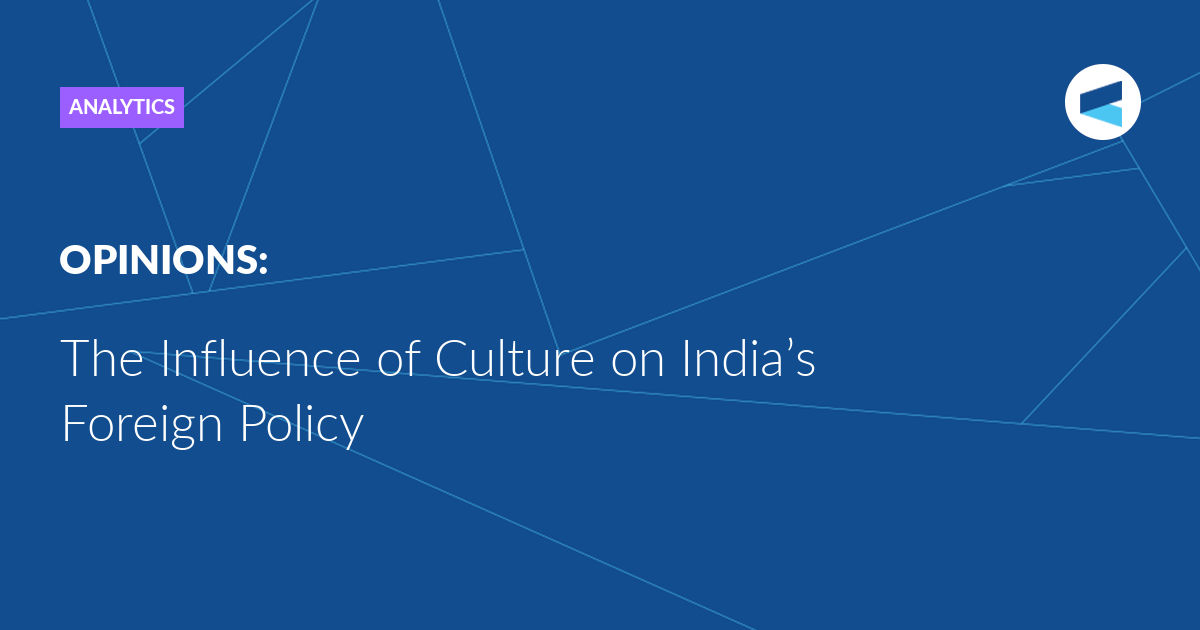India’s culture plays a significant role in shaping its foreign policy. India employs soft power, such as music, dance, literature, yoga, and cuisine to promote its image abroad. Indian cinema has a massive global appeal. India’s doctrine of Ahimsa (non-violence) has influenced its foreign policy approach. India played a crucial role in the Non-Aligned Movement during the Cold War, advocating for peaceful coexistence, independence, and development among nations.
Geopolitics in broad terms is a relationship between the geography, resources, demography, culture, ideology and political system of a nation state that determines its international relations. Culture is a blend of a nation’s core values, beliefs, traditions, patterns of behaviour, habits, symbols, achievements and particular ways of adapting to the strategic environment.
Foreign policy is how a country uses different strategies to guide its relationships with other countries and international organizations. Modern India’s foreign relations were established during the Versailles peace conference of 1919, in London, where then-British India was represented by the Maharajah of Bikaner. This led to Indian membership in the League of Nations and to its role as one of the founding members of the United Nations, even before India’s independence. British India’s embassy in Washington included Indian officials in some of its key diplomatic positions.
India’s contemporary foreign policy, in essence, is a multi-vector engagement under the rubric of strategic autonomy. It is guided by the ancient philosophy of Vasudhaiva Kutumbakam, a phrase found in the ancient Sanskrit scripture Maha Upanishad, implying that “the world is one family”. The universal appeal of the concept “One Earth, One Family, One Future” promoted by India during the G20 summit is well-established. India’s contemporary foreign policy is essentially informed by the vision of Viksit Bharat (Developed India 2047), articulated by Prime Minister Modi. Viksit Bharat 2047 represents India’s ambitious vision to transform the nation into a developed entity by the centenary of its independence in 2047. It seeks comprehensive national development, complemented by credible deterrence in a multipolar world. The operative guidelines for the accomplishment of the aforementioned vision are enunciated in the form of slogans such as NARA (National Ambition and Regional Aspiration), Sabka Saath-Sabka Vikas, Sabka Vishwas-Sabka Prayas (Participative Inclusive Growth) , Security and Growth for all in the Region (SAGAR), Digital India, and Atma Nirbhar Bharat (Self-Reliance). India adheres to the five Principles of Panchseel (Sovereignty, Non-aggression, Non-interference, Equality and Peaceful Coexistence). India is a staunch proponent of a rule-based, non-hegemonic and multipolar world order. It is against joining any blocks or military alliances, advocates free access to the global commons, non-discriminatory policies towards trade and technology, the non-militarisation of space and is against the unilateral imposition of models of governance. It has played a vital role in initiatives such as the International Solar Alliance (ISA), International Yoga Day, and the Coalition of Disaster Resilient Infrastructure (CDRI). It champions the cause of the Global South and reforms in the UN, as well as other international organisations, making them more representative, inclusive and effective. It has shown firm commitment to meeting climate-change related obligations, by striving to become climate neutral by 2070.
India’s culture of forging friendships and partnerships has greatly influenced its foreign policy. By leveraging its soft power, historical connections, diaspora engagement, and commitment to peacekeeping, the concept of Atithi Devo Bhava (the guest is equivalent to God), emphasizes the importance of hospitality and treating strangers with kindness and respect. It is this spirit that provided space for various religions to bloom in India concurrently. India is well-respected for its benign and principled foreign policy. India in essence is a civilisational state that draws immensely from its ancient wisdom. The ancient scriptures, the Vedas, present a comprehensive worldview that emphasize the interconnectedness of all beings and the harmonious functioning of the universe. They outline the concept of Rita or cosmic order, reflecting the balance and interdependence of the natural and moral laws. The Puranas, another series of ancient scriptures, provide insights into ancient customs, rituals, art forms, and social structures, giving us a glimpse into the rich cultural heritage of ancient India. The Upanishads recognize the fundamental unity of all religions and spiritual paths. They promote tolerance, respect, and inclusivity towards all religious and spiritual traditions. The Ramayana, a hugely popular epic, celebrates the virtues of righteousness, loyalty, courage, and selflessness.. The Mahabharata, another Sanskrit epic, is a classic narrative of statecraft. It explores themes such as dharma (righteousness), karma (action and its consequences), duty, loyalty, honour, sacrifice, love, and the pursuit of truth. It emphasizes that violence should be the last resort and highlights the significance of diplomacy and peaceful resolutions. The Bhagavad Gita is widely revered as an ultimate treatise of statecraft that encompasses moral, socio-political, economic, intelligence, diplomatic and cognitive domains. It is a guide to understanding duty as a warrior and the fight for justice. Lord Krishna, in the thick of a raging battle sermonises to the great warrior Arjuna in these words, “I am a Warrior; defending my Nation is my dharma. I will train my mind, body and spirit to fight; excel in all devices and weapons of war, present and future; always protect the weak; be truthful and forthright; be humane, cultured and compassionate; fight and embrace the consequences willingly. God, give me strength that I may ask nothing of you.” The Gita explains the significance of controlling one’s mind and senses through meditation and yoga.
More significantly, India’s strategic culture is shaped by the well-known statesman Kautalya (Chanakya), who lived during the Mauryan Empire, around the 4th century BCE. His Chanakya Neeti (policy) is a collection of guidelines that cover strategic planning, diplomacy, decision making, governance, economics, morality, and codes of conduct. Taking a cue from Chanakya thought, Nehru in the Constituent Assembly on December 4, 1947, said “talking about foreign policies, the House must remember that these are not just empty struggles on a chessboard. Behind them lie all manner of things. Ultimately, foreign policy is the outcome of economic policy, and until India has properly evolved from her economic policy, her foreign policy will be rather vague, rather inchoate, and will be grouping.”
The Chanakya’s Arthashastra is another ancient Indian treatise on statecraft and military strategy.
To understand its cultural impact on Indian statecraft and foreign policy, the study of Kautalya Saptang theory (Seven Limbed Theory) is essential. It depicts seven essential elements of a state for developing comprehensive national power and its strategic configuration for achieving national interests. These are the ruler, council of ministers, boundaries, defensive layout, economy, defence forces and alliances. Forming strategic alliances with neighbouring states is important for the state’s security and prosperity. These alliances can provide support during conflicts and help in maintaining a favourable geopolitical environment.
The Mandala Theory
is another significant concept mentioned in Arthashastra that influences India’s foreign policy. It posits that the political landscape is divided into concentric circles, known as mandalas. The central state is surrounded by other states, each with its own interests and ambitions. The relationships between these states can be categorized into four types based on their proximity to the central state:Q
- States that share a friendly relationship and common interests with the central state are considered allies. These alliances can be formal or informal and are formed to counter common threats or to pursue common goals.
- States that pose a direct threat or oppose the interests of the central state are considered enemies. The central state should be wary of these states and adopt measures to defend against their aggression.
- Allies or Enemies: These states are located in proximity to either allies or enemies of the central state. The central state should assess their intentions and take appropriate actions to neutralize any potential threats.
- Neutral or Indifferent States: These states do not pose an immediate threat or have significant alliances with the central state. They are considered neutral or indifferent, and the central state should actively maintain diplomatic relations with them to prevent any potential hostility.
The Mandala Theory highlights the dynamic nature of inter-state relationships and the need for strategic thinking and diplomacy. It suggests that the central state should focus on building alliances, assessing threats, neutralizing potential adversaries, and maintaining a favourable geopolitical environment to ensure its own security and power.
Chanakya further propounded the concept of Sam (Persuasion), Dam (Punishment), Dand (Force) Bhed (Divide). The Sam, Dam, Dand, Bhed concept provides strategies for a ruler to maintain control, manage conflicts, and protect interests. These approaches are rooted in an understanding of human nature, power dynamics, and the necessity of adapting strategies according to the specific circumstances and challenges faced by the ruler.
Suffice is to say that India’s culture plays a significant role in shaping its foreign policy. India employs soft power, such as music, dance, literature, yoga, and cuisine to promote its image abroad. Indian cinema has a massive global appeal. India’s doctrine of Ahimsa (non-violence) has influenced its foreign policy approach. India played a crucial role in the Non-Aligned Movement during the Cold War, advocating for peaceful coexistence, independence, and development among nations. India’s large diaspora community around the world, estimated to number over 30 million people, has had a profound impact on its foreign policy. India’s historical connections with neighbouring countries, particularly in Southeast Asia, have shaped its foreign policy. The spread of Indian religions like Buddhism and Hinduism, along with cultural exchanges, have established enduring ties that influence India’s approach to regional cooperation and diplomacy. India’s commitment to peacekeeping efforts under the UN flag demonstrates its cultural values of compassion, peace, and harmony. The Indian Council for Cultural Relations plays a crucial role in organizing cultural festivals, promoting educational scholarships, and facilitating cultural exchanges to foster goodwill, understanding, and friendship between nations. In sum, India is a brand name of unity in diversity; a melting pot of civilisations amalgamated seamlessly through cultural soft power. Our political system, with certain adaptations, can serve as model for several multi-ethnic societies.
The Valdai Discussion Club was established in 2004. It is named after Lake Valdai, which is located close to Veliky Novgorod, where the Club’s first meeting took place.
Please visit the firm link to site






